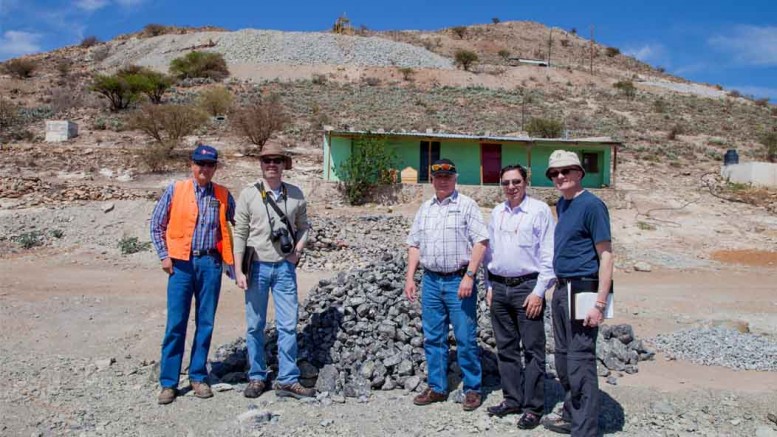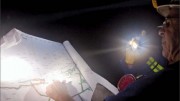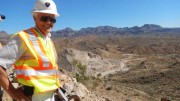After waiting more than 30 years, Southern Silver Exploration’s (SSV-V) man in Durango is finally getting a crack at the Cerro Las Minitas silver property.
Adrian Robles, Southern Silver’s senior exploration manager in Mexico, first came across the property in 1978 while working for Fresnillo (FRES-L) and then later with Kennecott. Both times the property ownership was too fractured to make it worthwhile.
It wasn’t until 2010, while working with Southern Silver, that Robles heard the small hill and surrounding land were finally up for grabs. The company struck a deal with the landowner for full control of a 151-sq.-km property in exchange for $4 million in cash over three years — $900,000 of which has been paid. The company also secured property for a potential mill site last October for 50,000 shares and $40,000 in cash. The one hole in Southern’s property is a small block called Puro Corazon, where rudimentary, small-scale mining is still taking place, but the company is expecting to reach a deal on that chunk, too.
Meanwhile, the active Puro Corazon claims are a reminder to Southern that there still is high-grade silver in the small hill that forms the focus of the company’s exploration. The hill, sitting in the northwest corner of the company’s claims, is pockmarked with adits containing enough high-grade silver to be mined in part by pick and shovel.
Southern was drawn to the silver-rich hill by historical workings that showed several types of silver, lead and zinc-enriched pipes, veins and replacement deposits distributed in the skarn-altered margins of a large, intrusive body. But the property’s true potential didn’t reveal itself until the company began more advanced exploration, stepping outside the main intrusive stock and the areas of historical exploration.
Rather than chase the surface showings as the old miners had done, the company used induced-polarization geophysics to identify new hidden targets — using fresh data the company drilled — and hit an entirely new discovery in June 2011.
Named the Blind zone, the discovery sits under a flat expanse of rusty coloured dirt just west of the Cerro Las Minitas hill. Discovery hole number 6 returned 3 metres grading 514 grams silver per tonne, 12.8% lead and 0.9% zinc from 216 metres downhole, and 4 metres carrying 184 grams silver, 2% copper and 18.4% zinc from 411 metres downhole.
“The real potential is where you follow [the mineralization] off into the ground cover,” says Rob MacDonald, general manager of exploration, as we look out on the other side of the hill at more red dirt to the southeast that the company has yet to touch.
Wanting to build on its discovery rather than chase new ones, though, Southern has concentrated drilling at the Blind zone, so far delineating an 800-metre-long zone with a resource estimate expected later this year. Results from drilling have included hole 8 that returned 3 metres carrying 818 grams silver, 12.9% lead and 10.9% zinc; hole 21 that returned 0.5 metre averaging 920 grams silver, 18.4% lead and 11.1% zinc; and hole 22 that cut 0.9 metre carrying 611 grams silver, 18.5% lead and 13.1% zinc.
At the Blind zone the company has identified monzonitic to felsic intrusions in the host limestone stratigraphy, with mineralization occurring on the margins of the intrusion. So far the data seems to show two main, mineralized horizons with good continuity and several secondary structures that may turn into definable lenses with more drilling.
The company is looking forward to a substantive resource estimate on the Blind zone, and the smaller El Sol zone beside it, but acknowledges the deposit alone won’t radically change its fortunes. But the resource will provide an anchor of legitimacy from which it hopes to add ounces from other untested targets at Cerro Las Minitas.
And with many company-making deposits in the Faja de Plata — or silver belt — of north-central Mexico in which the property sits, Southern thinks there’s ample opportunity to find a big one. The belt is one of the world’s great silver districts, hosting such giants as Fresnillo’s eponymous mine — which has been in operation since 1554, and last year produced 30 million oz. silver plus gold, lead and zinc — and Goldcorp’s (G-T, GG-N) large Penasquito mine with 16 million oz. gold, almost a billion oz. silver, 6 billion lb. lead and 15 billion lb. zinc.
Projects even closer to home include Orko Silver’s (OK-V) 150-million-oz. La Preciosa silver project, Avino Silver & Gold Mines’ (ASM-V, ASM-X) Avino mine — in production since the 1500s — and Hecla Mining’s (HL-N) San Sebastian exploration project hosting 15 million oz. silver, plus gold, zinc and lead.
Southern’s property is located less than 30 km from these projects and 70 km northeast of the city of Durango. After flying into the sleepy Durango airport, the drive to the property follows a smooth and quiet highway, thanks to the toll booths that dot its length.
The company bases operations out of Ciudad Guadalupe Victoria, a city located on the edge of its property boundary that makes accommodations and sourcing basic supplies simple. The town of 5,000 has a couple of paved streets and no buildings over two stories, but you can find great barbecue and eager local workers. From the town it’s a few minutes drive to the main site along a dirt road, roughened by the haul trucks from the active mining property and the garbage trucks making the run to the local dump.
Southern is working away at delineating a resource, with 8,000 metres drilled last year and 7,200 metres drilled in 32 holes so far this year. The company is targeting 20,000 metres this year to get itself a resource.
Because of market conditions, the company has zeroed in almost entirely on the Blind zone.
“We’ve focused here because we’re focused on results, results, results — but there’s a lot of potential still out there,” Roger says.
The company has started stepout drilling, and hit a new zone of gold-copper mineralization under gravel cover 1.5 km southeast of the Blind zone. Hole 55 returned a 20-metre interval in a hematite breccia averaging 0.8 gram gold, including 4 metres grading 2.8 grams gold and 28 grams silver. A second 4-metre interval returned 1.4 grams gold, 89 grams silver and 1.8% copper, hosted in chlorite-garnet skarn.
Southern noted that this latest discovery is significant because it demonstrates large-scale metal zoning across multiple structures, and raises the potential for discovering a gold-enriched deposit on the property.
The company plans to follow up on this latest discovery, as well as several targets identified through the induced-polarization survey, while looking for the next Blind zone.
Unfortunately, financial troubles could limit exploration. The company had planned a $5-million financing from some select backers, but the deal was derailed in April and the company settled for a $662,000 financing, leaving it with $1.5 million in early May.
Southern still hopes to get that financing, with company president Lawrence Page working on bringing more money in, helped by his board, including recently appointed director Jean-Pierre Colin. Page has extensive experience in the industry, having been a director and officer at the companies that discovered and brought into production the David Bell and Page Williams mines in Ontario and the Snip, Eskay Creek and Mascot gold mines in B.C., while Colin is a long-time investment banker with broad financial connections.
But management has its work cut out to raise money, with Sou
thern hovering around 6¢ and already having 128.2 million shares outstanding. Outstanding warrants, at between 20¢ and 22¢, could add 76 million to the total.
If the company ever does find itself flush with cash, though, it has a lot of targets to choose from at its Cerro Las Minitas project, plus its Oro bulk-tonnage gold property in New Mexico, and its Dragoon copper project in Arizona where Freeport-McMoRan Copper & Gold (FCX-N) is earning into by 70%.
Robles, for one, is eager to explore Cerro Las Minitas — having waited so long to get the chance — and anxious to find the next Blind zone. “Honestly, I don’t believe this is the only Blind zone in the area,” he says.






Be the first to comment on "Southern Silver eyes next Blind zone"